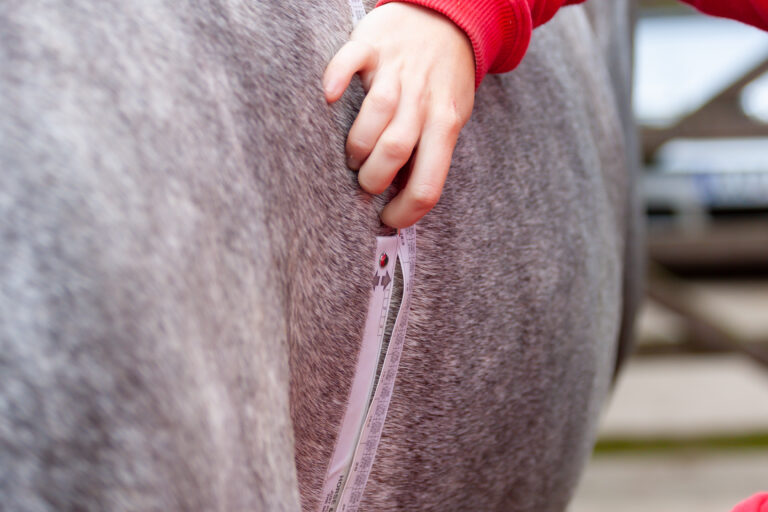
Healthy horses’ skin is naturally resistant to bacterial and fungal infection. As such, the vast majority of skin infections are secondary to an underlying cause. Rather than just dispensing antimicrobials without further investigation, veterinarians need to identify the primary cause and treat both it and the secondary infection, explained Richard Coppack, AVPCert Vet Dermatology, director of Coppax/EVC Compounding Ltd, in the U.K. He described topical and systemic treatment strategies for equine skin infections at the 2025 British Equine Veterinary Association Congress.
Causes and Pathogens
“Identifying and treating the underlying cause is just as important at treating the infection,” said Coppack. “Any insult to the skin barrier will allow these bacteria to get in.” Common causes include:
- Trauma (including self-trauma).
- Ectoparasites (e.g., chorioptic mange).
- Chemical irritation.
- Keratinization defect.
- Hygiene/damp (e.g., mud fever).
- Photosensitization.
- Immune-mediated disease (e.g., pemphigus).
To combat antibiotic resistance, practitioners should take a skin swab and try to identify the bacteria or fungus via cytology and ideally using culture and sensitivity. Coppack said cytology is easy to perform in the clinic with Diff-quick staining and at least a 40X magnification microscope.
“It doesn’t take long to recognize cocci, rods, and yeasts within minutes,” he said. “If you do this routinely, you’ll start to develop an eye for them.”
If the skin lesions you’re trying to swab are dry, Coppack recommended applying sterile water to the tip of the swab, rolling it over the lesion, then putting it into the transport medium. Infections that have passed through the dermis and into the subcutaneous tissue result in cellulitis. To swab these, you can either sample discharge from an entry hole or, if that’s not an option, use ultrasound to scan for pockets of fluid you can sample with a needle.
He noted that in a recent paper on 76 cases of pastern dermatitis, researchers identified 41 different species of bacteria. Streptococcus and Staphylococcus bacteria were the most frequent isolates (~40%).
Topical Treatments
Most topical treatments we use on horses have been extrapolated from use in humans and dogs. “There’s a lack of basic research on equines,” said Coppack. Common antiseptic and antimicrobial agents include:
| Antiseptic Agent | Concentration | Usage | Susceptibility |
| Chlorhexidine | 4% | 10 mins application, rinse off | Bacteria and some fungi |
| Povidone iodine | 2-5% | 10 mins application, rinse off | Bacteria and fungi |
| Chloroxylenol | 5% | 5 mins application, rinse off | Bacteria and fungi |
| Hypochlorous acid | 0.025% | Liquid, apply and leave on | Bacteria and fungi |
| Manuka honey | > UMF 10 | Viscous liquid, apply and leave on | Bacteria and fungi |
| Antibiotic | Concentration | Dose Interval |
| Fusidic acid | 0.5% | q 12-24 hours |
| Bacitracin | 1% | q 12-24 hours |
| Silver sulfadiazine | 1% | q 24 hours |
| Polymyxin B | 0.1% | q 12-24 hours, but avoid if possible |
| Neomycin | 0.5% | q 12-24 hours, but avoid if possible |
For topicals to be effective, said Coppack, you must use the correct contact time and warm or hot water to open up the hair follicles so the agent can penetrate them.
“There’s a tendency to lather it up and wash it right off,” he said. “People also tend to do it too frequently. Treat perhaps every 48 hours initially, then stretch treatments to twice weekly. If you’ve got the right stuff and you’re treating the underlying cause, it should be improving.”
Coppack said he advises against softening and removing scabs prior to treatment, though opinions on this practice vary.
If there’s no improvement after two to three weeks of treatment, revisit the diagnosis and underlying cause, he added.
Systemic Treatments
Where there are extensive or granulomatous lesions or where infection is extending into the subcutaneous tissue causing cellulitis, the use of systemic antibiotics can be justified, said Coppack.
Ideally, antibiotics should be used in accordance with cytology, culture, and sensitivity. Avoid using critically important antibiotics where possible. Common systemic antibiotics include:
| Antibiotic | Dose Rate | Route |
| Trimethoprim/Sulfadiazine | 30 mg/kg combined q 12 hrs | Oral |
| Doxycycline | 10-20 mg/kg q 12 hrs | Oral |
| Enrofloxacin | 7.5-10 mg/kg q 24 hrs | Oral, avoid if possible |
| Ceftiofur | 2.2 mg/kg q 12-24 hrs | I/M – avoid if possible |
| Penicillin | 12-15 mg/kg q 12 hrs | I/M |
| Gentamycin | 6.6 mg/kg q 24 hrs | I/V – avoid if possible |
Generally, veterinarians administer systemic antibiotics twice a day and at the higher dose—you want to ensure minimum inhibitory concentration (MIC) in the dermis, said Coppack.
Fungal Infections
For superficial fungal skin infections (dermatophytes, Malassezia, Candida), treat topically with conazoles (e.g., enilconazole, miconazole) or povidone iodine 2%. For deeper infections, such as fungal granuloma, treat with systemic conazoles (e.g., itraconazole, fluconazole), amphotericin B, or potassium iodide.
Overtreatment
With any equine skin infection that has gone on for a couple of weeks, your first thought should be whether you made the right diagnosis, said Coppack.
“In chronic cases, the original underlying cause may have passed, but the infected skin is perpetuated by the owner persisting daily treatment,” he said. “If treatment has continued for months or even years, allowing a one- to two-week break will allow the vet to assess this.”
Review the horse’s signalment, environment, history, clinical lesions, and response to treatment, and perform further testing.
Related Reading
- Chlorhexidine vs. Alcohol Antisepsis for Equine Surgical Procedures
- Strategies for Equine Bandaging and Splinting Success
- Research Spotlight: Equine Wound Healing
Stay in the know! Sign up for EquiManagement’s FREE weekly newsletters to get the latest equine research, disease alerts, and vet practice updates delivered straight to your inbox.

![[Aggregator] Downloaded image for imported item #18383](https://s3.amazonaws.com/wp-s3-equimanagement.com/wp-content/uploads/2025/09/30141253/EDCC-Unbranded-29-scaled-1-768x512.jpeg)


